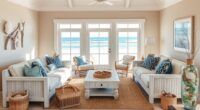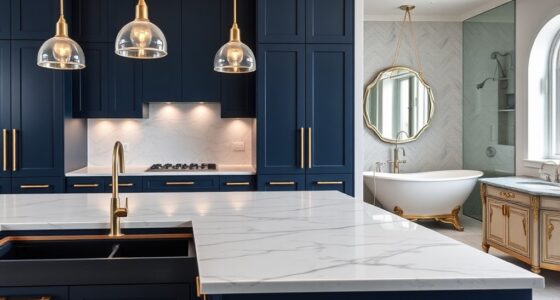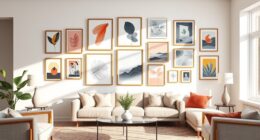The design process from concept to installation guides you through planning, collaborating with clients, developing creative ideas, producing technical details, and managing logistics. You start with defining your project’s scope and gathering input to align expectations. Then, you create visual concepts and refine them based on feedback. Next, you prepare detailed drawings and coordinate with others. Finally, you oversee on-site work to make sure everything comes together smoothly. Keep exploring to discover how each step transforms your vision into reality.
Key Takeaways
- Develop a comprehensive project plan outlining scope, objectives, timeline, resources, and budget to guide the entire process.
- Collaborate with clients through communication and visual references to align on their vision and expectations.
- Create conceptual visualizations like sketches and mood boards to explore ideas and refine designs with client input.
- Produce detailed technical drawings, specifications, and collaborate with engineers to ensure manufacturability and functionality.
- Manage logistics, procurement, and on-site activities to execute the design seamlessly and deliver the final installation.

The design process transforms a simple idea into a fully realized installation through careful planning and execution. When you begin, it’s essential to focus on project planning, which acts as the blueprint for your entire endeavor. This step involves defining the scope, setting clear objectives, and establishing a realistic timeline. You’ll need to assess your resources, budget, and constraints early on, so you can make informed decisions moving forward. During this phase, client collaboration is vital. Engaging with your client allows you to understand their vision, preferences, and expectations. Open communication ensures everyone is aligned and helps prevent misunderstandings later. You might hold meetings, ask targeted questions, and gather visual references to capture the essence of what they want to achieve.
As you develop your project plan, you’ll start creating sketches, mood boards, or digital models to visualize ideas. This is where your creativity begins to take shape, but it’s also a time for critical thinking. You need to balance aesthetic appeal with practical considerations like structural integrity, safety, and functionality. Throughout this process, ongoing client collaboration remains crucial. Regular updates and feedback sessions help you refine your design and ensure it stays true to the client’s vision. This iterative process might involve presenting concepts, discussing modifications, and making adjustments until everyone is satisfied.
Once your plan is solidified, you move into the detailed design phase. Here, you’ll produce technical drawings, specifications, and material lists that serve as the foundation for actual construction or installation. You may work with engineers or fabricators at this stage to troubleshoot potential issues and optimize your design for manufacturability. During this phase, staying in close contact with your client ensures that your detailed plans still reflect their desires. It’s your opportunity to clarify any uncertainties, explain your choices, and incorporate their input. Additionally, understanding sustainable practices can contribute to eco-friendly and durable outcomes.
As you shift from planning to execution, your focus shifts to managing logistics and coordinating resources. You’ll oversee procurement, scheduling, and on-site activities to keep everything on track. Throughout the installation, maintaining communication with your client is essential to address any unforeseen challenges swiftly. Your careful project planning combined with active client collaboration forms the backbone of a seamless transition from concept to installation. When you approach each stage with clarity, openness, and precision, you’re more likely to deliver a final product that not only meets expectations but also exceeds them.
Frequently Asked Questions
How Do Designers Choose Sustainable Materials for Projects?
You choose sustainable materials by researching eco-friendly options and prioritizing those with low environmental impact. You consider material sourcing, opting for locally sourced or recycled materials to reduce carbon footprint. You also evaluate durability and lifecycle, ensuring your selections promote longevity and recyclability. By staying informed on eco-labels and certifications, you confidently incorporate sustainable choices that align with your project’s environmental goals while maintaining quality and aesthetic appeal.
What Software Tools Are Most Effective in the Design Process?
You should focus on software tools like digital sketching and 3D modeling programs, which are highly effective in the design process. Digital sketching allows you to quickly explore ideas and make revisions, while 3D modeling helps you visualize and refine your concepts in detail. These tools streamline your workflow, enhance accuracy, and enable real-time adjustments, making your design process more efficient and creatively flexible.
How Is Client Feedback Integrated During Development Phases?
Think of client feedback like a vintage radio, preserving essential signals while tuning out static. You actively incorporate client collaboration by establishing regular feedback loops, where clients review designs and share insights. This ongoing communication helps you refine ideas, ensuring the final product aligns with their vision. By keeping feedback loops open and responsive, you create a dynamic process that fosters trust and results in a design that truly meets client expectations.
What Are Common Challenges Faced During Installation?
During installation, you often face hurdles like unexpected site constraints, which can delay progress. You might encounter issues with limited space, uneven surfaces, or access problems that complicate your work. These challenges require quick thinking and flexibility to adapt plans accordingly. By planning for potential site constraints and communicating with your team, you can overcome installation hurdles more efficiently, ensuring the project stays on track despite unforeseen obstacles.
How Do Budgets Influence the Design Choices Made?
Think of your budget as a map guiding your design journey. Budget constraints shape your choices, steering you toward options that are cost-effective solutions. You might have to skip luxury finishes or opt for versatile materials, but this focus guarantees your project stays financially feasible. By prioritizing essential elements, you create a balanced design that fulfills your vision without overspending, keeping the project on track and within your means.
Conclusion
By now, you see how every step in the design process is essential—from brainstorming ideas to flawless installation. When you pay attention to detail and stay committed, your project can transform spaces more breathtaking than you ever imagined. Remember, this process isn’t just a routine; it’s your chance to create something truly extraordinary that leaves a lasting impact. Keep pushing forward—you’re capable of turning visions into reality more seamlessly than you think!









